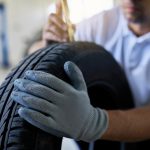
Sumber: https://www.freepik.com/free-photo/closeup-auto-repairman-measuring-depth-car-tire-auto-repair-shop_26399904.htm
For any commercial fleet operator, the concept of tire retreading is a cornerstone of operational efficiency. It’s a powerful strategy that transforms a massive operational expense into a manageable, circular asset. But the value of a retread is not in the new rubber; it’s in the structural soundness of the asset being reused. The entire promise of a safe, reliable, and cost-effective “second life” for a tire rests exclusively on the integrity of its casing.
A retread is only as good as the casing it’s built upon. Yet, the most dangerous flaws—internal separations, micro-punctures, and corroding steel belts—are completely invisible to the naked eye. Relying on a simple visual check or a “thump test” is a gamble, and in the transportation industry, gambling leads to catastrophic failures, vehicle downtime, and spiraling costs.
This is where advanced, non-destructive inspection techniques separate amateur operations from professional retreading facilities. This article dives into the essential inspection technologies that are non-negotiable for any fleet manager who values safety and a low Total Cost of Ownership (TCO).
Why Casing Integrity is Everything
A commercial truck tire is an engineering marvel. The tread, the part we see, is designed to be worn away. The casing—the complex architecture of steel belts, bead bundles, and inner liners—is the expensive, over-engineered part designed to last for hundreds of thousands of miles, far beyond the life of the original tread.
The casing is the foundation of a skyscraper. You can’t build a new penthouse (the tread) on a crumbling foundation.
Casing integrity isn’t just about “no leaks.” It is the complete absence of:
- Separations: Voids or “bubbles” between any of the tire’s layers (e.g., between the steel belts or between the tread and the casing).
- Moisture Ingress: Water that has penetrated the inner liner and begun to rust the structural steel belts.
- Puncture Damage: Not just the hole itself, but the “channel” of damage the object created as it moved through the tire’s structure.
- Bead Damage: Any deformity in the bead area that would prevent a perfect air-tight seal on the rim.
A failure in any of these areas can lead to a “zipper failure” or a “blowout” at highway speeds. According to the Tire Retread & Repair Information Bureau (TRIB), tires retreaded using proper, standardized processes (which are heavily reliant on inspection) are just as safe and durable as new tires. The key word is properly.
The “Old Way” vs. The “Right Way”: Limits of Visual Inspection
The first step in any tire retreading inspection process is, and always will be, a thorough tactile and visual examination. A trained technician will run their hands over the entire casing, looking for obvious, disqualifying flaws:
- Large, non-repairable cuts or punctures (especially in the sidewall).
- Signs of “run-flat” damage (creases or visible charring on the inner liner).
- Chemical or ozone damage (excessive cracking).
- Deformed or exposed beads.
But this process, while necessary, is critically insufficient. It’s like a doctor diagnosing a patient by only looking at them. It cannot see internal injuries. A casing can look perfect on the inspection stand but be harboring a catastrophic “belt-edge separation” from a severe pothole impact weeks prior. This flaw, invisible to the eye, will almost certainly fail once the new tread is applied and the tire is put back under 100+ PSI of pressure and a 40-ton load.
This is why professional retreaders must become “radiologists,” using technology to see inside the casing.
The Advanced Inspection Toolkit: Seeing the Unseeable
Modern, high-volume retread plants invest heavily in a suite of non-destructive testing (NDT) equipment. Here are the core technologies and what they find.
1. High-Pressure NDT (Non-Destructive Testing)
Before any other test, the casing must prove it can still hold air under pressure. The casing is mounted on a rim inside a heavily reinforced steel safety cage.
- How it Works: The tire is inflated to a high pressure, often 120 PSI or more, which is significantly higher than its normal operating pressure. The technician then inspects it for several minutes.
- What it Finds: This is a “stress test” that reveals gross structural failures. It can expose weak spots, bead seating problems, and “zipper failures”—a rapid, catastrophic rip along the sidewall—in a contained, safe environment. If a casing can’t survive this test, it is immediately scrapped.
2. Electronic Liner Inspection (ELI)
The inner liner of a tubeless tire is its most critical air-retention component. It’s designed to be perfectly airtight. However, small punctures, whether from a nail or from a “run-flat” event, can create micro-cracks or pinholes that are impossible to see.
- How it Works: The casing is passed through a station where it is wetted (to create a conductive surface) and an electrical probe is passed over the entire inner liner. A low-voltage current is applied.
- What it Finds: If there is a pinhole, even one that doesn’t go all the way through, the electricity will complete a circuit and trigger an alarm, pinpointing the exact location of the flaw. This allows the technician to repair a simple pinhole before it becomes a major leak and prevents moisture from being trapped inside the casing during the curing process.
3. Shearography (Laser Interferometry)
This is the gold standard for tire retreading inspection and the technology that truly separates the best from the rest. Shearography is designed to find the most dangerous flaw of all: separations.
- How it Works:
- The casing is placed in a large, sealed vacuum chamber.
- A highly precise laser scans the entire surface of the tire, creating a digital “fingerprint” of its topography.
- A slight vacuum is applied inside the chamber. This small change in pressure causes the air trapped in any internal void or “bubble” (a separation) to expand, deforming the tire’s surface by mere nanometers.
- The laser scans the tire a second time.
- A computer compares the “before” and “after” images. This process, called interferometry, highlights any area that deformed under the vacuum. These anomalies are displayed on a screen as bright, colored blotches.
- What it Finds: This is the only technology that reliably finds belt-edge separations, shoulder separations, trapped moisture, and air pockets that are invisible to X-rays and the naked eye. It provides a complete map of the casing’s internal bond integrity.
4. X-Ray Inspection
Where Shearography is brilliant at finding separations (voids), X-ray is the champion at finding “hard” flaws.
- How it Works: Just like a medical X-ray, the casing is passed in front of an X-ray emitter, and a sensor on the other side captures an image of its internal structure.
- What it Finds: X-ray allows the technician to see the steel belts with perfect clarity. It will immediately reveal:
- Broken or kinked steel wires.
- Rust and corrosion on the belts (caused by moisture).
- The precise path of a puncture (to see if it damaged the belts).
- Foreign objects (like a nail fragment) still embedded deep in the rubber.
A top-tier plant will often use both X-ray and Shearography. X-ray validates the steel structure, and Shearography validates the bond integrity. A casing that passes both of these tests is a proven asset.
What This Means for You, the Fleet Manager
When you’re choosing a tire retreading partner, the conversation shouldn’t just be about price-per-retread or tread patterns. The most important question you can ask is: “What is your casing inspection process?”
- Demand Transparency: Ask for a tour of their plant. Do you see an NDT inflation cage? Do you see a Shearography or X-Ray machine? If their process relies only on a technician’s eyeball, you are accepting a massive, unnecessary risk.
- Lower Your TCO: A slightly higher price for a retread that has been through advanced inspection is an investment, not a cost. It dramatically lowers your TCO by preventing on-road failures, reducing downtime, and extending the life of your casing assets for multiple retread cycles.
- Ensure Safety and Compliance: A documented, technology-driven inspection process is your best defense in any post-accident litigation or DOT/compliance audit. It proves you performed your due diligence.
The tire retreading industry has evolved. It is no longer a low-tech “repair” job; it is a high-tech remanufacturing process. The technology exists to identify nearly every potential flaw. Don’t settle for a partner who chooses to guess.
If you are a fleet manager looking for a tire retreading partner that prioritizes safety and maximizes asset value through advanced, verifiable inspection techniques, contact the experts at Rubberman today.








